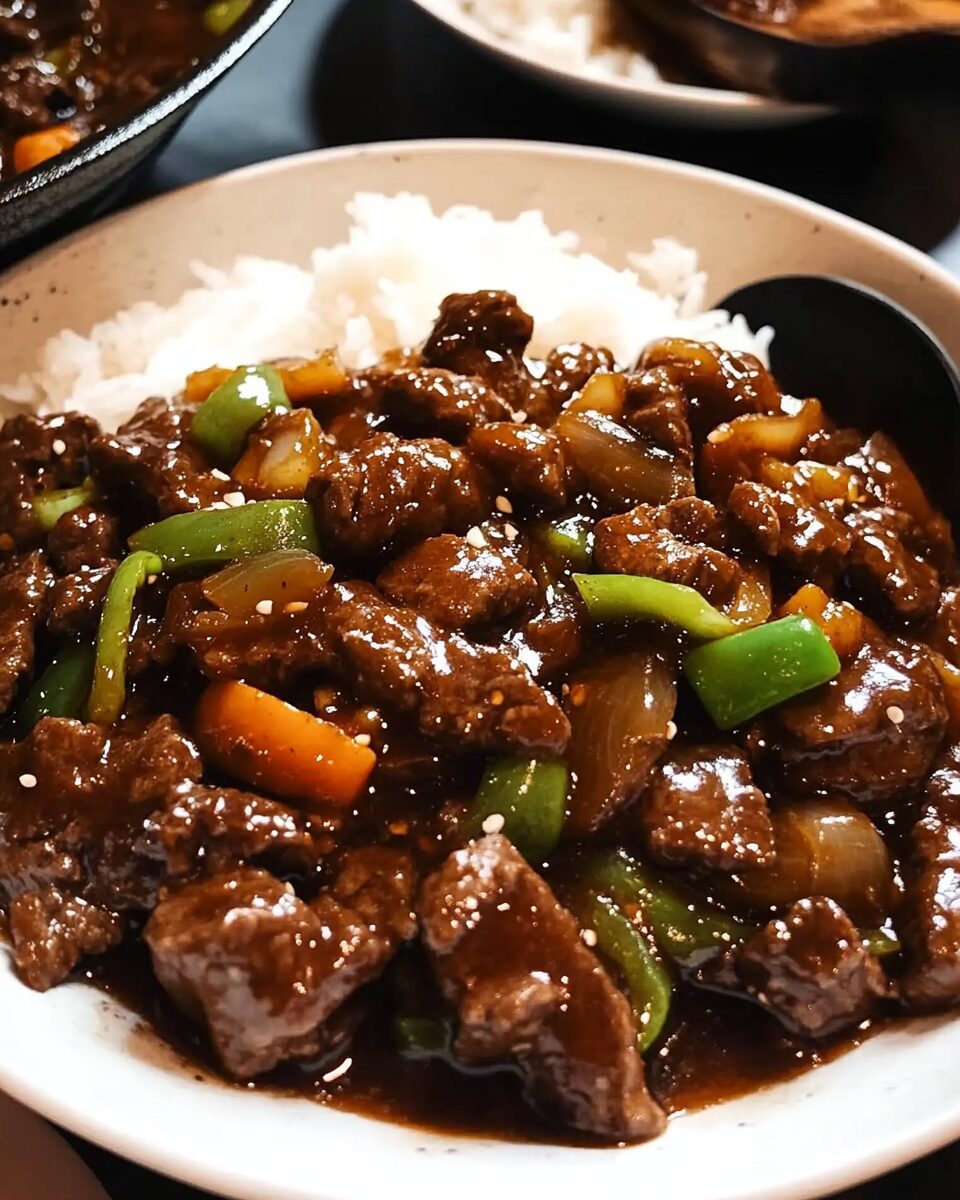This Beef in Black Bean Sauce is a savory, glossy masterpiece made with tender slices of marinated beef, pungent preserved black beans, and crisp bell peppers. Balanced with a hint of sweetness and a silky sauce, it’s a recipe that brings restaurant-quality Chinese flavor to your kitchen without the cost or additives.
Each bite hits with bold umami, gentle heat, and the irresistible aroma of wok-seared aromatics. Whether you’re serving it over steamed jasmine rice or spooning it into a lunch box, this dish is a game changer for anyone craving a deep dive into traditional Chinese home-style cooking. A guaranteed crowd-pleaser that’s as fun to cook as it is to eat.
Full Recipe:
-
400g / 14 oz rump steak (top sirloin), thinly sliced
-
1/2 cup preserved black beans (salted and fermented soy beans)
-
1 brown onion, cut into 1-inch squares
-
1 green capsicum (bell pepper), cut into 1-inch squares
-
1 tbsp garlic, finely minced (~4 cloves)
-
1/2 cup peanut oil (or canola/vegetable oil)
-
1 tbsp Chinese cooking wine (Shaoxing wine)
Tenderizing Marinade:
-
1 tbsp light soy sauce
-
1 tsp dark soy sauce
-
1 tbsp oyster sauce
-
2 tsp cornflour (cornstarch)
-
1/4 tsp baking soda
-
1 tbsp toasted sesame oil
Sauce:
-
1 tbsp light soy sauce
-
2 tsp white sugar
-
2 tbsp cornflour
-
1 cup water
Directions:
-
Mix all marinade ingredients except sesame oil and coat beef. Add sesame oil last and toss again. Marinate in fridge for 1 hour.
-
Soak preserved black beans in water for 30–60 minutes, then drain.
-
Mix sauce ingredients in a bowl until smooth. Set aside.
-
Heat oil in a wok over high heat. Shallow fry beef for 30 seconds until browned. Remove beef and set aside.
-
Discard excess oil, keeping 3 tbsp in the wok.
-
Stir black beans for 20 seconds. Add garlic and stir for 10 more seconds.
-
Add onion and capsicum, stir-fry for 1 minute until slightly softened.
-
Return beef to the wok. Toss for 30 seconds.
-
Pour cooking wine around the edge of the wok. Toss for 30 seconds.
-
Add sauce and stir until thick and glossy (about 1 minute).
-
Serve hot with steamed rice.
Prep Time: 20 minutes | Cooking Time: 10 minutes | Total Time: 30 minutes
Kcal: 421 kcal | Servings: 5 servings
A Culinary Classic: The Story Behind Beef in Black Bean Sauce
Beef in Black Bean Sauce is a time-honored dish with deep roots in Cantonese cuisine, often seen in Chinese restaurant menus worldwide. But when prepared with authentic techniques and the right ingredients, this dish transcends the takeout experience and becomes something truly special. It’s not just about beef and sauce—it’s a harmonious blend of savory, earthy, and umami flavors coming together in a sizzling wok.
This beloved stir fry combines thin slices of tender beef with aromatics, colorful vegetables, and a distinctive sauce made with fermented black beans. The result is a rich, glossy dish with layers of complexity, born from the wisdom of generations of Chinese chefs and perfected over time.
The Origins of Black Bean Sauce
To truly appreciate this dish, it’s essential to understand one of its core ingredients: fermented black beans. Known as douchi in Mandarin or dau si in Cantonese, these are black soybeans that have been fermented in salt. Unlike the common black beans used in Western cooking, douchi offers a pungent aroma, deep umami flavor, and an unmistakable punch that defines this dish.
Fermented black beans have been used in Chinese cuisine for over 2,000 years and are considered one of the oldest food condiments in the world. They are a staple in many Southern Chinese provinces and form the base of several sauces and stews. In Beef in Black Bean Sauce, they are briefly soaked to release their bold flavor, then quickly stir-fried with garlic and vegetables to permeate the dish with depth and complexity.
Cultural Significance and Popularity
In Chinese households and restaurants, Beef in Black Bean Sauce is more than just a dinner—it’s comfort food, a dish that feels like home. Traditionally served with white jasmine rice, it’s a quick but meaningful meal that’s both satisfying and packed with nutrition. Its popularity isn’t limited to China; it has become a mainstay in Western Chinese restaurants due to its strong flavor and widespread appeal.
In cities like Hong Kong, Sydney, London, or San Francisco, this dish is frequently ordered for its bold yet balanced flavor profile. The contrast between tender beef and crunchy vegetables combined with the umami of the sauce has made it a global favorite.
Why This Recipe Stands Out
While many versions of this dish exist, not all are created equal. Store-bought black bean sauces often lack the punch and authenticity that fermented black beans provide. This particular rendition—shared by Chef Hannah from the RecipeTin Meals team—uses a scratch-made sauce and authentic Chinese techniques, elevating it beyond what you typically find at takeout spots.
Chef Hannah, born and raised in China in a family of chefs, brings her culinary heritage into this recipe. Her method not only preserves the integrity of the ingredients but also enhances the dining experience. By using the correct cut of beef, marinating it for tenderness, and applying proper wok techniques, she ensures that the result is restaurant-quality food made easily at home.
What makes this recipe truly shine is its attention to detail. From marinating the beef with a small amount of baking soda to tenderize it, to soaking the preserved black beans for a more pleasant bite, every step is purpose-driven. The sauce itself is minimalistic yet powerful, allowing the fermented black beans to lead the flavor profile rather than overwhelm it.
Tips from Professional Chinese Kitchens
One of the standout characteristics of this recipe is the method of shallow-frying the beef, as opposed to just stir-frying. This technique, often used in restaurant kitchens, gives the beef a delicate, slippery texture that enhances its mouthfeel. Though it requires a little more oil, the payoff in taste and texture is well worth it.
Additionally, pouring Chinese cooking wine (Shaoxing wine) around the perimeter of the wok instead of directly into the food is a technique that releases the wine’s fragrance before it fully mixes with the other ingredients. This is a small but impactful trick commonly employed by experienced Chinese chefs to add aromatic depth.
Such methods, though subtle, make a significant difference in authenticity and flavor. The ability to replicate these techniques at home helps bridge the gap between home-cooked meals and professional restaurant dishes.
Flavor Profile and Pairings
Beef in Black Bean Sauce is bold but not spicy. Its saltiness comes from the black beans, while the beef brings richness, and the vegetables (typically onion and bell peppers) offer sweetness and crunch. The sauce is thick, glossy, and clings beautifully to the beef and vegetables, making each bite deeply satisfying.
While it is traditionally paired with steamed jasmine rice, it also goes well with stir-fried noodles, cauliflower rice for a low-carb option, or even tucked into a wrap or bao for a fusion take.
To elevate the meal, consider pairing it with a light soup (like egg drop or seaweed tofu soup) or a simple cucumber salad to contrast the rich flavors. For drinks, a jasmine green tea or a crisp lager beer works well to cleanse the palate between bites.
Health and Budget Benefits
Beyond its taste, this recipe has some practical advantages. Compared to high-end restaurant prices (often over $30 for a small portion), this homemade version costs a fraction—sometimes less than $15 for four to five generous servings. This makes it not just a flavor-forward option but a budget-conscious one as well.
Nutritionally, it offers a well-rounded profile: protein from the beef, fiber and vitamins from the vegetables, and minimal sugars. While sodium levels can be on the higher side due to fermented beans and soy sauce, soaking the beans and balancing the dish with fresh ingredients helps moderate the saltiness. It’s also naturally dairy-free and easily made gluten-free with the right soy sauce substitute.
Storage and Leftovers
One of the perks of this dish is how well it keeps. Leftovers store nicely in the refrigerator for up to three days and reheat without losing texture or flavor. However, freezing is not recommended as the sauce may thin out and lose its desirable consistency. That said, it makes a fantastic meal prep option for busy weekdays or quick lunches.
Conclusion: A Must-Try Staple for Home Cooks
Beef in Black Bean Sauce isn’t just another stir-fry—it’s a celebration of Chinese culinary tradition. With its rich history, unique ingredients, and bold flavors, this dish captures what makes Asian home cooking so beloved around the world. It’s proof that restaurant-quality meals can be achieved at home, even without a professional kitchen or exotic equipment.
Whether you’re new to Chinese cooking or an experienced home chef looking for something deeply authentic, this recipe delivers. From its budget-friendly nature to its rich flavor and culinary techniques, it checks all the boxes for a meal that’s both nostalgic and exciting.
Try it once, and it might just earn a permanent spot in your cooking rotation—bringing the flavors of Guangzhou or Hong Kong straight into your dining room.






